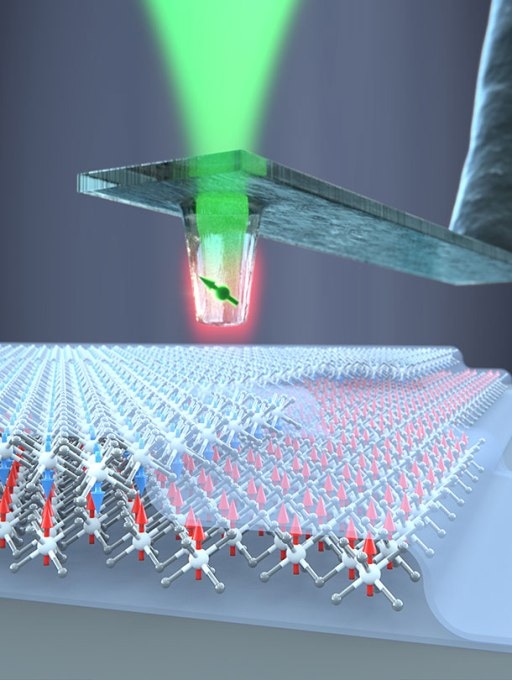Apr 26 2019
Physicists at the University of Basel have successfully measured the magnetic properties of atomically thin van der Waals materials on the nanoscale for the first time. They employed diamond quantum sensors to establish the strength of the magnetization of separate atomic layers of the material chromium triiodide (CrI3). Furthermore, they discovered a long-sought clarification for the material’s rare magnetic properties. Their findings have been published in the journal Science.
 A diamond quantum sensor is used to determine the magnetic properties of individual atomic layers of the material chromium triiodide in a quantitative manner. It was shown that the direction of the spins in successive layers alternate in the layers. (University of Basel, Department of Physics)
A diamond quantum sensor is used to determine the magnetic properties of individual atomic layers of the material chromium triiodide in a quantitative manner. It was shown that the direction of the spins in successive layers alternate in the layers. (University of Basel, Department of Physics)
Atomically thin, two-dimensional (2D) van der Waals materials hold promise for applications in several fields in technology and science. Researchers globally are continually investigating new ways to stack various single atomic layers and thus design new materials with unique, emerging characteristics.
These super-thin composite materials are contained together by van der Waals forces and frequently act contrarily to bulk crystals of the same material. Atomically thin van der Waals materials comprise of semiconductors, insulators, superconductors and a few materials with magnetic properties. Their application in spintronics or ultra-compact magnetic memory media is very promising.
The first quantitative measurement of magnetization
Up till now, it was not possible to establish the alignment, strength, and structure of these magnets quantitatively nor on the nanoscale. The team guided by Georg-H.-Endress Professor Patrick Maletinsky from the Department of Physics and the Swiss Nanoscience Institute at the University of Basel have shown that the use of diamond tips adorned with single electron spins in an atomic force microscope is preferably suited to these kinds of studies.
Our method, which uses the individual spins in diamond color centers as sensors, opens up a whole new field. The magnetic properties of two-dimensional materials can now be studied on the nanoscale and even in a quantitative manner. Our innovative quantum sensors are perfectly suited to this complex task.
Patrick Maletinsky, Georg-H.-Endress Professor, Department of Physics, Swiss Nanoscience Institute, University of Basel.
The number of layers is critical
Using this technology which was initially created in Basel and founded on a single electron spin, the researchers partnered with scientists from the University of Geneva to establish the magnetic properties of single atomic layers of CrI3. The scientists were thus able to get the answer to a core scientific question regarding the magnetism of this material.
As a three-dimensional, bulk crystal, CrI3 is completely magnetically ordered. In the case of few atomic layers, however, just stacks with an odd number of atomic layers reveal a non-zero magnetization. Stacks with an even number of layers display an antiferromagnetic property; that is, they are not magnetized. The cause of this “even/odd-effect” and the inconsistency to bulk material was formerly unidentified.
Strain as the cause
Maletinsky’s team was able to establish that this occurrence is because of the specific atomic arrangement of the layers. During sample preparation, each CrI3 layer slightly moves against one another. The subsequent strain in the lattice means the spins of following layers are incapable of aligning in the same direction; rather, the spin direction alternates in the layers. With an even number of layers, the magnetization of the layers nullifies; with an odd number, the strength of the measured magnetization matches that of a single layer.
However, when the strain in the stack is let loose – for instance, by puncturing the sample – the spins of all layers can line up in the same direction, as is also seen in bulk crystals. The magnetic strength of the whole stack is the same as the sum of the separate layers.
The study carried out by the Basel researchers, thus, not only answers a core question relating to 2D van der Waals magnets, but also opens stimulating viewpoints on how their novel quantum sensors can be used in the future to explore 2D magnets so as to add to the progress of innovative electronic components.